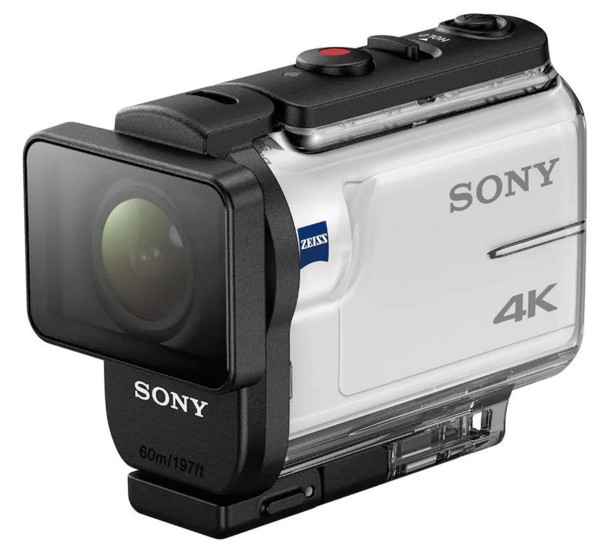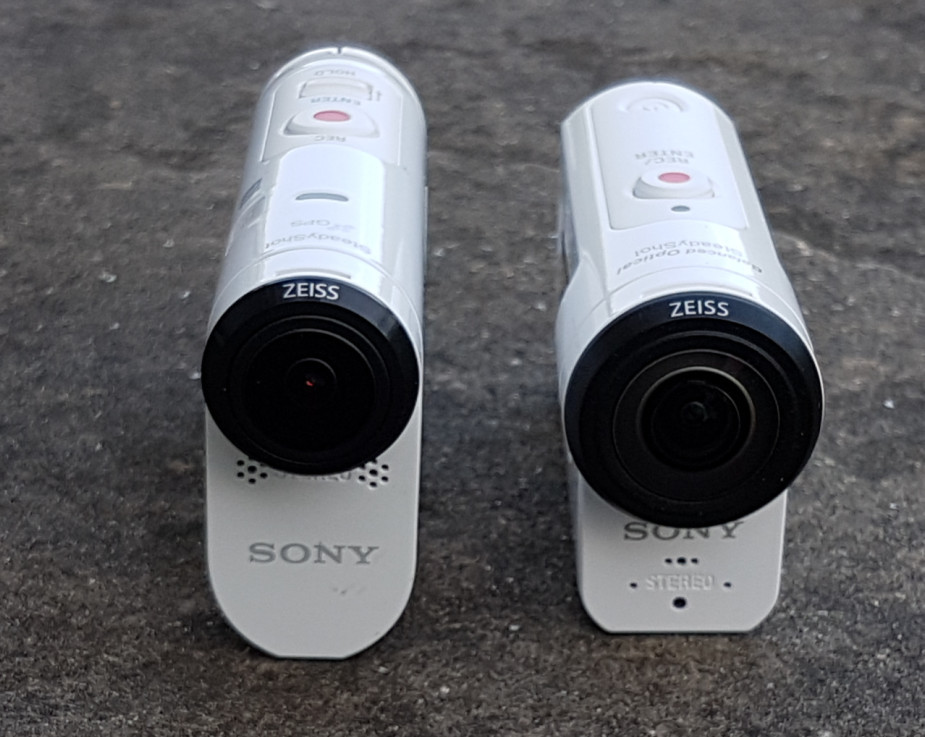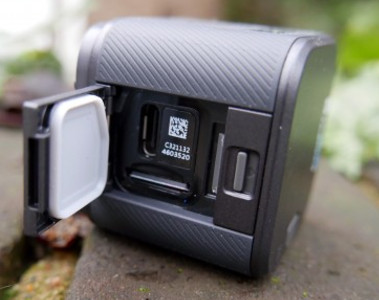@euroflyer are you still selling the FDR-1000V for €2?
I got my hands on the X3000 camera (the successor to the 1000V) waterproof housing – cost about 50 quid

and the front plate is glass, not plastic. That opens up the possibility of ice protection, via some sort of metallic coating and electrical heating. It would be a fun experiment to get that working. There are firms out there that do optical coatings but mostly for antireflection purposes.
I would give it to you if it was still alive… my daughter converted it into a diver’s camera in Italy in summer. Unfortunately, with no particular diver attached 
So I got myself a gopro hero, which I still keep and I’m quite happy with it… lots of stuff available and I also can fix it to the ski helmet…..
Problem with the hero is the awful distortion. And all except the last have no stabilisation.
The distortion can be corrected in software and I did that a lot in 2016 but it degrades the image especially in corners.
So I will eventually move to the X3000 which needs almost no lens correction and is optically stabilised. It also reportedly works with a 256gb sd card.
That’s right, there is distortion, but I’m happy I can film at all :)
Well, I finally could not resist and bought the X3000.
Optically stabilised even at 4K, works with a 256GB card (this one is one of the very few that works) to deliver 9hrs at 4K 30fps, and has much less image distortion due to the bigger lens

One issue I found is that none of the X3000’s three angle of view options is close to the X1000’s “120 degree” setting (obtained implicitly by enabling stabilisation; you don’t get a choice).
The best I could get is setting the 3000 to Wide (the widest option) and Active stabilisation (which is both optical and in software) and this gives me a measured 109 degrees field of view (measured in the horizontal plane only so not a correct FOV figure in photographic terms). This is 13% wider than the X1000 in its “120 degree” mode which gives a measured 96 degrees. So I have 13% more FOV but the image distortion is better, because of the 3000’s better lens, which is actually better for flying movies where you do want a reasonably wide angle but where distortion makes the footage look like the “go-pro teletubby” stuff which IMHO nobody wants to watch more than once 
One can correct distortion in the video editor but due to its nonlinearity there seems to be no way to do it perfectly (I don’t know of any editor plug-in which does camera model specific lens correction for action cams) and if you correct the image properly near the middle you get weird artefacts in the corners.
I did a quick and dirty 1080P video showing the before and after lens correction in Vegas
Due to the smaller need for lens correction, there is a relative absence of corner artefacts (scenery speeding up into the corner) which is visible in all the lens-corrected ex-X1000 videos e.g. this one done
The X3000 software is also much better. It is roughly 1990s VCR user interface standard, whereas the X1000 was a early 1980s VCR user interface standard. Sony, for all their R&D, simply cannot write any decent software. And I think all the action cams (which all use Sony sensors) are based on some sensor evaluation kit which Sony offer, and Sony didn’t bother making it any good. But this doesn’t matter because the camera is set up and not changed.
Further tests show this camera to be really good for this application.
It works with external power fine, subject to the internal battery being at least 50% charged. The reason for this limitation is not clear but it seems that the firmware fails to keep track of the battery charge during recording with external power connected…
Unlike the X1000 which had a serious bug in that external power did not work for recording unless it was at least 5.1V at the instant the camera was turned on (the Sony “hardware designer” must have been smoking some Japanese weed), the X3000 works down to 4.5V unconditionally. I tested it down to -25C and it then needs 4.6V. Note that this is the voltage at the camera; USB cables can have large drops; even expensive ones.
The camera draws up to 0.85A (measured at 4K max bitrate, but with wifi etc turned off) and it does need an intelligent USB charger which can negotiate up to 2A. A 1A charger will not work usefully; it draws only 0.47A from it and runs the battery down. It took me a while to work this out.
With the 256GB card, it will do about 8hrs at 4K 60mbits/sec 30fps which exceeds the longest possible TB20 flight. Most users would be able to use the top mode: 4K 100mbits/sec 30fps which does about 5hrs. Then you end up with a nice 256GB video file but that’s your problem  Quality doesn’t come cheap or easy.
Quality doesn’t come cheap or easy.
One piece of brain-dead Sony design in the X3000:
You cannot delete files over USB. The internal storage is write-protected!
This is nonsensical if the camera is inside its waterproof housing and for whatever reason you don’t want to remove it !!
The only way I can see around this silly behaviour is to enable wifi in the camera and then the smartphone remote control app allows you to Format the card (the android ones does, anyway).
The waterproof housing does allow one to operate the menus and Format the card also but it may not be practical to do that in some situations. I have modified my waterproof housing with a USB cable going into it and can extract the files that way without opening the housing, but still can’t clear the card!
In many situations this will dictate having the wifi enabled the whole time (to enable the remote control app to work). There is some bluetooth functionality but I think it is a remote on/off only.
The X3000 turns out to be very sensitive to airframe vibration. It upsets its optical stabilisation, resulting in a “jello” effect, visible here around 0:30 (but in reality is present all the time) if you watch the large version carefully:
At 1080, the software stabilisation deals with this well, but at 4K this is not available because it relies on the sensor being bigger than the frame size and then accelerometer signals are used to move around the part of the sensor which is used.
Disabling stabilisation at 4K (which disables only the optical stabilisation, since the software stabilisation wasn’t available anyway) deals with the jello and you get a pretty solid video. This is a 4K upload, suitably degraded by Vimeo but you can use the Download feature to get the original 3GB image.
How does it deal with people who want to connect outside audio-in to the camera ? Does the camera mount still so cleverly cover all the plugs (which was the reason I bought the gopro) ?
There are photos online e.g. here. I don’t think the mike socket is obscured.
For an externally mounted camera you can’t really bring in audio via cable and they have not supported a bluetooth mike profile so I use a separate recorder which is started at the same time as the camera and which connects into the aircraft intercom. Obviously there are other solutions (this and other threads) but this one is the simplest and doesn’t distract the pilot.
Obviously the sockets are obscured when using the waterproof housing, which is generally necessary for any external mounting. One can modify the housing, and have the cable(s) coming out in a waterproof manner, and I did that, but most people won’t be doing that because it’s quite tricky to do it right. I did it just for USB power.
The Go Pro Session 4K looks good too, but reviews suggest the quality is not as good. It is a lot cheaper than the Sony; not much more than half the price. It is waterproof without an external housing, which is great, but one would have to do some surgery with epoxy to bring in a power cable

Basically one would have to attach the cable, seal around the plug with silicone, and then pour in a sealant into that cavity so the camera is waterproof again.
Why external power? The batteries in all these last about 1hr at 4K.